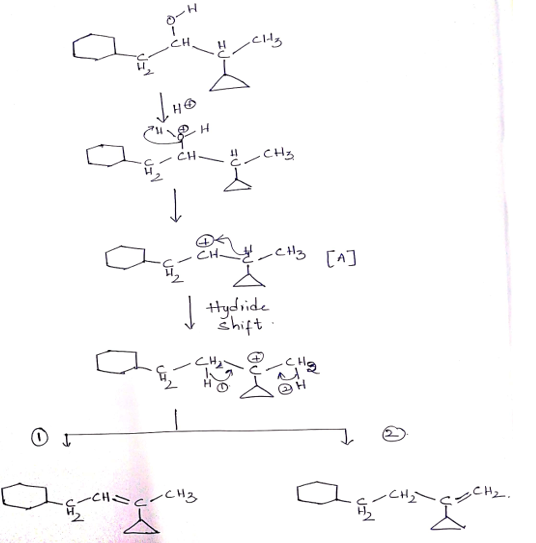Below is a schematic representation of possible reactions that Compound X can undergo. Use the scheme to answer the following questions A)Illustrating with reaction mechanisms, show how compounds [1], [2], [3] and [4] are formed. Image attached below
Below is a schematic representation of possible reactions that Compound X can undergo. Use the scheme to answer the following questions A)Illustrating with reaction mechanisms, show how compounds [1], [2], [3] and [4] are formed. Image attached below
Chemistry
10th Edition
ISBN:9781305957404
Author:Steven S. Zumdahl, Susan A. Zumdahl, Donald J. DeCoste
Publisher:Steven S. Zumdahl, Susan A. Zumdahl, Donald J. DeCoste
Chapter1: Chemical Foundations
Section: Chapter Questions
Problem 1RQ: Define and explain the differences between the following terms. a. law and theory b. theory and...
Related questions
Question
Below is a schematic representation of possible reactions that Compound X can undergo. Use the scheme to answer the following questions
A)Illustrating with reaction mechanisms, show how compounds [1], [2], [3] and [4] are formed.
Image attached below
![CH2
CH3
+
H2
[2]
[1]
[ A]
OH
CH
CH3
H2
Compound X
( ii )
[B]
CH3
CH3
[4]
[3]](/v2/_next/image?url=https%3A%2F%2Fcontent.bartleby.com%2Fqna-images%2Fquestion%2F5eceea66-02b3-43c1-a36b-b40c2b8f36f0%2Fbc47ed95-6953-444a-9034-2d1b0003f509%2F5vki2g_processed.jpeg&w=3840&q=75)
Transcribed Image Text:CH2
CH3
+
H2
[2]
[1]
[ A]
OH
CH
CH3
H2
Compound X
( ii )
[B]
CH3
CH3
[4]
[3]
Expert Solution
Step 1
Step 1:
B). The type of reaction involved in both (i) and (ii) is dehydration of alcohol (removal of a water molecule) to an alkene in the presence of a strong acid like sulphuric acid.
The only difference in both the reactions is the formation of carbocation and rearrangement of carbocation by hydride ion shift giving all four products. The reaction mechanism involved in the formation of products 1 and 2 is shown below.

Step by step
Solved in 2 steps with 2 images

Knowledge Booster
Learn more about
Need a deep-dive on the concept behind this application? Look no further. Learn more about this topic, chemistry and related others by exploring similar questions and additional content below.Recommended textbooks for you

Chemistry
Chemistry
ISBN:
9781305957404
Author:
Steven S. Zumdahl, Susan A. Zumdahl, Donald J. DeCoste
Publisher:
Cengage Learning

Chemistry
Chemistry
ISBN:
9781259911156
Author:
Raymond Chang Dr., Jason Overby Professor
Publisher:
McGraw-Hill Education

Principles of Instrumental Analysis
Chemistry
ISBN:
9781305577213
Author:
Douglas A. Skoog, F. James Holler, Stanley R. Crouch
Publisher:
Cengage Learning

Chemistry
Chemistry
ISBN:
9781305957404
Author:
Steven S. Zumdahl, Susan A. Zumdahl, Donald J. DeCoste
Publisher:
Cengage Learning

Chemistry
Chemistry
ISBN:
9781259911156
Author:
Raymond Chang Dr., Jason Overby Professor
Publisher:
McGraw-Hill Education

Principles of Instrumental Analysis
Chemistry
ISBN:
9781305577213
Author:
Douglas A. Skoog, F. James Holler, Stanley R. Crouch
Publisher:
Cengage Learning

Organic Chemistry
Chemistry
ISBN:
9780078021558
Author:
Janice Gorzynski Smith Dr.
Publisher:
McGraw-Hill Education

Chemistry: Principles and Reactions
Chemistry
ISBN:
9781305079373
Author:
William L. Masterton, Cecile N. Hurley
Publisher:
Cengage Learning

Elementary Principles of Chemical Processes, Bind…
Chemistry
ISBN:
9781118431221
Author:
Richard M. Felder, Ronald W. Rousseau, Lisa G. Bullard
Publisher:
WILEY